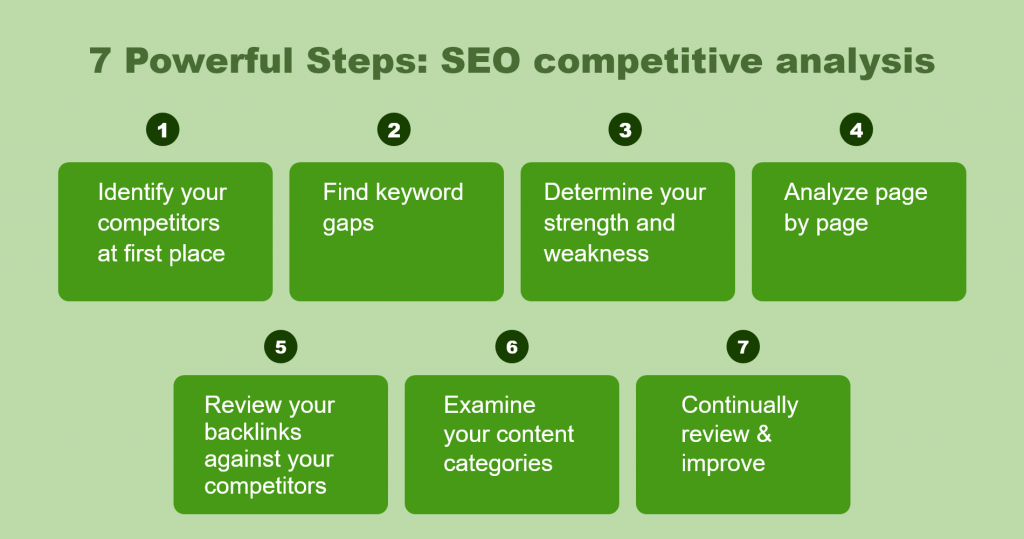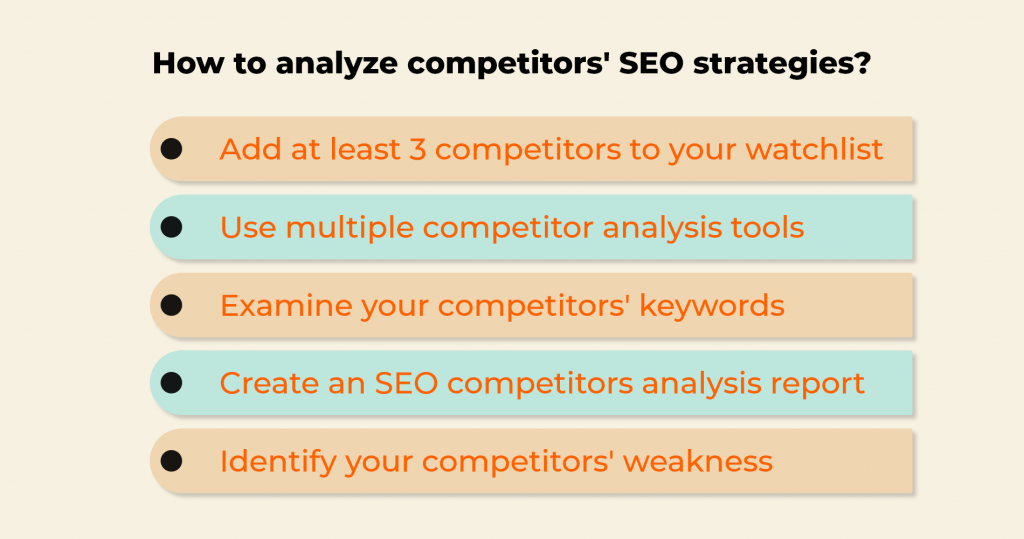Uncover the secrets to dominating your competition in the world of SEO with these expert tips and strategies revealed.

Image courtesy of via DALL-E 3
Table of Contents
Welcome, young SEO enthusiasts! Today, we’re diving into the exciting world of SEO competitive analysis. Have you ever wondered how some websites manage to appear at the top of search engine results while others don’t? Well, that’s where SEO competitive analysis comes into play. By understanding and utilizing SEO strategies, you can outrank your competitors and climb the ranks in the online world.
What is SEO?
SEO stands for Search Engine Optimization. In simple terms, it’s the process of optimizing your website so that it shows up higher in search engine results like Google. The goal is to make your website more visible to people searching for specific keywords related to your content or business.
Why Compete?
Competing with other websites is essential in the digital landscape. Understanding your competitors’ strategies can help you identify trends, weaknesses, and opportunities in your own approach. By analyzing and outperforming your rivals, you can attract more visitors to your website and increase your online presence.
Identify Your Competitors
In this section, we will help you figure out who your competitors are so you can understand who you are up against in the online world.
Direct Competitors
Direct competitors are businesses or websites that offer similar products or services to yours. These competitors are the most obvious threats to your online success because they are vying for the same customers or audience as you. Identifying your direct competitors will help you analyze their strategies and see where you can improve to outrank them in search engine results.
Indirect Competitors
Indirect competitors may not offer exactly the same products or services as you, but they still target the same audience or customers. These competitors can still impact your online visibility and success. Identifying your indirect competitors will help you understand the broader market landscape and adjust your strategies accordingly to stay ahead in the competition.
Research Competitor Keywords
In this section, we will dive into the importance of researching competitor keywords to understand what works best for them.
Using SEO Tools
SEO tools are like magic wands that help us find out which keywords our competitors are using to attract more visitors to their websites. Tools like Ubersuggest or Google Keyword Planner can show us the most popular keywords that competitors are ranking for. Just like a detective, we can use these tools to uncover the secret keywords that make our competitors stand out.
Picking the Right Keywords
Once we have uncovered the keywords our competitors are using, it’s time to pick the best ones for our own website. We need to choose the keywords that are not too common but still relate to what we offer. These are the keywords that can help us outrank our competitors and attract more visitors to our site. It’s like finding the perfect treasure map that leads us to success!
Analyze Competitor Content
In this section, we will explore how to analyze competitor content to gain insights into what works in online marketing.

Image courtesy of www.serpple.com via Google Images
Identify Popular Content
One way to analyze competitor content is by identifying which pieces attract the most attention from readers. Look for blog posts, videos, or social media posts that receive a lot of likes, shares, and comments. By understanding what your competitors’ audience finds engaging, you can tailor your own content to appeal to a similar audience.
Quality vs Quantity
It’s essential to focus on quality rather than quantity when creating content. While it’s important to have a consistent online presence, it’s even more critical to offer valuable, well-researched, and engaging content. High-quality content not only attracts more readers but also helps build credibility and trust with your audience. Remember, it’s better to have a few outstanding pieces of content than a large volume of mediocre content.
Check Competitor Backlinks
Competitor backlinks are an essential part of SEO competitive analysis. By understanding your competitors’ backlink profiles, you can gain valuable insights into their strategies and identify opportunities to improve your own site’s backlink profile.
What are Backlinks?
Backlinks are links from other websites that direct users to your site. They serve as a vote of confidence in your content and can significantly impact your search engine rankings. The more high-quality backlinks you have, the more authoritative your site appears to search engines.
Using Backlink Tools
Tools like Ahrefs or Moz allow you to analyze your competitors’ backlink profiles. With these tools, you can see which websites are linking to your competitors, the quality of those backlinks, and the anchor text used. By studying your competitors’ backlinks, you can identify potential link building opportunities for your own site.
Evaluate Competitor Website Performance
When it comes to outranking your competitors online, it’s essential to evaluate their website performance. By understanding how well their site is optimized for search engines and user experience, you can identify areas where you can improve and gain a competitive edge. In this section, we will discuss how to compare your website’s performance to that of your competitors.

Image courtesy of www.serpple.com via Google Images
Site Speed
Site speed is a critical factor in SEO as well as user experience. Websites that load quickly tend to rank higher in search engine results and provide a better overall experience for visitors. To check your site’s speed, you can use tools like Google’s PageSpeed Insights or GTmetrix. Compare your site’s loading time with that of your competitors to see where you stand.
User Experience
Having a website that offers a great user experience is key to keeping visitors engaged and coming back for more. Evaluate your competitor’s websites to see how easy it is to navigate, how visually appealing it is, and how quickly users can find the information they’re looking for. Look for things like clear navigation menus, fast loading times, and mobile responsiveness.
Compare Social Media Presence
Having a strong social media presence is essential in today’s digital age. Let’s take a look at how you can compare your social media presence with that of your competitors to stay ahead in the online world.
Popular Platforms
Social media platforms like Facebook, Instagram, Twitter, and TikTok are where many people spend their time online. Each platform has its own unique features and audience demographics. By understanding which platforms your competitors are using and how they engage with their audience, you can better tailor your own social media strategy.
Engagement Metrics
Engagement on social media refers to how much your audience interacts with your content. This can include likes, shares, comments, and overall interaction with your posts. By comparing your engagement metrics with those of your competitors, you can see what is resonating with your audience and where you may need to make improvements.
Create an Action Plan
After conducting a thorough SEO competitive analysis, it’s time to create an action plan based on your findings. Here’s how you can effectively strategize to outrank your competitors:

Image courtesy of digitalmarketinginstitute.com via Google Images
Setting Goals
Setting clear and achievable goals is essential for a successful SEO strategy. Define what you aim to achieve – whether it’s improving website traffic, increasing rankings for specific keywords, or boosting conversion rates. By outlining your goals, you give your action plan direction and purpose.
Taking Action
Once you’ve set your goals, it’s time to take action. Start implementing the insights gained from your competitive analysis. This could involve optimizing your website content with relevant keywords, improving site speed and user experience, or developing a robust backlink strategy. Remember, consistent and strategic actions are key to surpassing your competition.
Summary
In this article, we discussed the importance of SEO competitive analysis in outranking competitors online. Let’s recap the key points we covered:
Recap Key Steps
We began by explaining what SEO (Search Engine Optimization) is and why it’s crucial for businesses to understand and utilize it to stand out in search results. Identifying competitors, both direct and indirect, is essential to know who you’re up against. Researching competitor keywords and analyzing their content and backlinks can provide valuable insights into successful strategies. Checking competitor website performance, comparing social media presence, and creating an action plan based on the analysis are important steps to take to improve your online presence and outrank competitors.
Frequently Asked Questions (FAQs)
What if I don’t have any competitors?
If someone thinks they don’t have competitors, it’s essential to broaden the scope of what competition means. Even if there aren’t direct competitors offering identical products or services, there are likely indirect competitors vying for the same audience. Understanding these indirect competitors can provide valuable insights and opportunities for growth.
How often should I do competitive analysis?
Performing competitive analysis should be a regular part of your digital marketing strategy. It’s recommended to conduct competitive analysis at least quarterly to stay updated on the latest trends, strategies, and changes in the competitive landscape. By staying vigilant and monitoring your competitors consistently, you can adapt your own tactics to stay ahead of the game.
What if my competitors outrank me despite all efforts?
If competitors continue to outrank your website despite your best efforts, it’s time to reassess your strategy. Consider analyzing their tactics further to identify what is working for them and how you can adapt or improve your own approach. Additionally, focus on creating high-quality, engaging content, building strong backlinks, and optimizing your website for better performance. Persistence and continual refinement of your SEO strategy can eventually help you regain your competitive edge.







